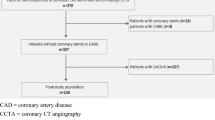Abstract
Purpose
To investigate the influence of virtual monochromatic spectral (VMS) CT images at different energy levels on the effectiveness of a motion correction technique (SSF) in dual-energy Spectral coronary CT angiography (CCTA).
Materials and methods
29 cases suspected of or diagnosed with coronary artery disease underwent Spectral CCTA using a prospective ECG triggering with 250 ms padding time. SSF was applied to the determined least-motion phase to generate 6 additional sets of VMS images with energy levels from 40 to 100 keV. CT value and standard deviation (SD) in the aortic root and epicardial adipose tissue were measured. Image quality of the RCA, LAD and LCX was evaluated on a per-vessel basis in each patient. Two reviewers evaluated the artery using the score of the segment.
Results
The low energy VMS images increased CT value and image noise compared with higher-energy VMS images, except 90 keV and 100 keV. The CNR of 40–70 keV were higher than those of 80–100 keV (P < 0.05). The image quality scores for images at 50–80 keV were higher than those of 40, 90, and 100 keV (P < 0.05), and the VMS image quality at 50 keV and 60 keV with SSF was the highest.
Conclusion
SSF can effectively reduce the motion artifacts when coronary vessels have suitable contrast enhancement which can be achieved by adjusting energy levels of VMS images.


Similar content being viewed by others
References
Feuchtner G, Loureiro R, Bezerra H, et al. Quantification of coronary stenosis by dual source computed tomography in patients: a comparative study with intravascular ultrasound and invasive angiography. Eur J Radiol. 2012;81:83–8.
Ding Z, Friedman MH. Quantification of 3-D coronary arterial motion using clinical biplane cineangiograms. Int J Cardiovasc Imaging. 2000;16:331–46.
Araoz PA, Kirsch J, Primak AN, Braun NN, et al. Optimal image reconstruction phase at low and high heart rates in dual-source CT coronary angiography. Int J Cardiovasc Imaging. 2009;25:837–45.
Leipsic J, Labounty TM, Hague CJ, et al. Effect of a novel vendor-specific motion-correction algorithm on image quality and diagnostic accuracy in persons undergoing coronary CT angiography without rate-control medications. J Cardiovasc Comput Tomogr. 2012;6:164–71.
Qianwen L, Pengyu L, Zhuangzhi S, et al. Effect of a novel motion correction algorithm (SSF) on the image quality of coronary CTA with intermediate heart rates: segment-based and vessel-based analyses. Eur J Radiol. 2014;83:2024–32.
Cheng J, Yin Y, Wu H, et al. Optimal monochromatic energy levels in spectral CT pulmonary angiography for the evaluation of pulmonary embolism. PLoS One. 2013;8:e63140.
Liang J, Wang H, Xu L, et al. Impact of SSF on diagnostic performance of coronary computed tomography angiography within 1 heart beat in patients with high heart rate using a 256-row detector computed tomography. J Comput Assist Tomogr. 2017;42:54–61.
Lee H, Kim JA, Lee JS, et al. Impact of a vendor-specific motion-correction algorithm on image quality, interpretability, and diagnostic performance of daily routine coronary CT angiography: influence of heart rate on the effect of motion-correction. Int J Cardiovasc Imaging. 2014;30:1603–12.
Achenbach S, Paul JF, Laurent F, et al. Comparative assessment of image quality for coronary CT angiography with iobitridol and two contrast agents with higher iodine concentrations: iopromide and iomeprol. A multicentre randomized double-blind trial. Eur Radiol. 2017;27:821–30.
Leipsic J, Abbara S, Achenbach S, et al. SCCT guidelines for the interpretation and reporting of coronary CT angiography: a report of the Society of Cardiovascular Computed Tomography Guidelines Committee. J Cardiovasc Comput Tomogr. 2014;8:342–58.
Hong C, Becker CR, Huber A, et al. ECG-gated reconstructed multi-detector row CT coronary angiography: effect of varying trigger delay on image quality. Radiology. 2001;220:712–7.
Li M, Zhang GM, Zhao JS, Jiang ZW, et al. Diagnostic performance of dual-source CT coronary angiography with and without heart rate control: systematic review and meta-analysis. Clin Radiol. 2014;69:163–71.
Hassanab A. Technical challenges of coronary CT angiography: today and tomorrow. Eur J Radiol. 2011;79(79):161–71.
Andreini D, Pontone G, Mushtaq S, et al. Low-dose CT coronary angiography with a novel IntraCycle motion-correction algorithm in patients with high heart rate or heart rate variability. Eur Heart J Cardiovasc Imaging. 2015;16:1093–100.
Machida H, Lin XZ, Fukui R, et al. Influence of the motion correction algorithm on the quality and interpretability of images of single-source 64-detector coronary CT angiography among patients grouped by heart rate. Jpn J Radiol. 2015;33:84–93.
Shechter G, Resar JR, Mcveigh ER. Displacement and velocity of the coronary arteries: cardiac and respiratory motion. IEEE Trans Med Imaging MI. 2006;25:369–75.
Ohana M, Labani A, Severac F, et al. Single source dual energy CT: what is the optimal monochromatic energy level for the analysis of the lung parenchyma? Eur J Radiol. 2017;88:163–70.
Wang XP, Wang B, Hou P, et al. Screening and comparison of polychromatic and monochromatic image reconstruction of abdominal arterial energy spectrum CT. J Biol Regul Homeost Agents. 2017;31:189–94.
Acknowledgements
This study was approved by the institutional review board of our hospital and a written informed consent was obtained from each participant prior to the study.
Funding
No external funding.
Author information
Authors and Affiliations
Corresponding author
Ethics declarations
Conflict of interest
Each author for this manuscript has participated sufficiently to take public responsibility and there were no conflicts of interest related to the work.
Additional information
Publisher's Note
Springer Nature remains neutral with regard to jurisdictional claims in published maps and institutional affiliations.
About this article
Cite this article
Jia, Y., Zhai, B., He, T. et al. Influence of virtual monochromatic spectral image at different energy levels on motion artifact correction in dual-energy spectral coronary CT angiography. Jpn J Radiol 37, 636–641 (2019). https://doi.org/10.1007/s11604-019-00852-0
Received:
Accepted:
Published:
Issue Date:
DOI: https://doi.org/10.1007/s11604-019-00852-0




